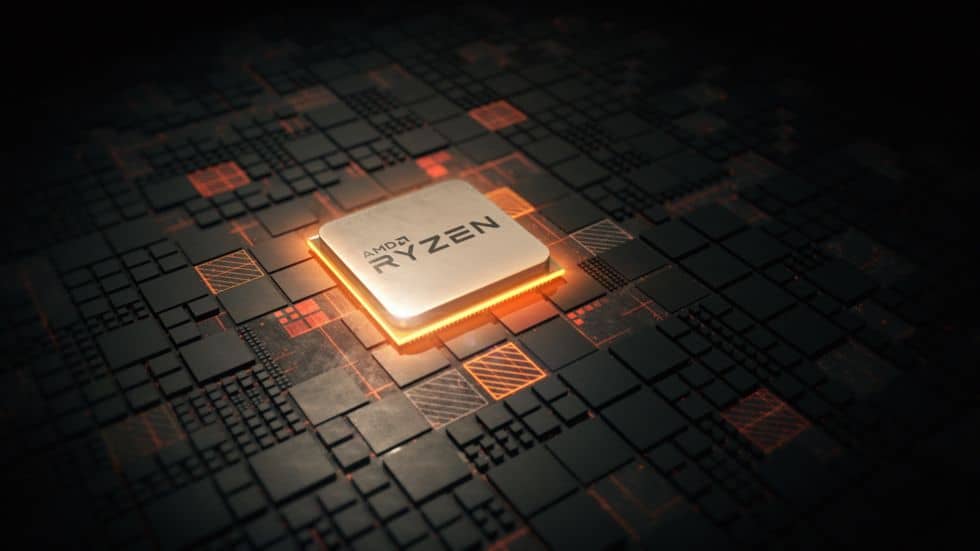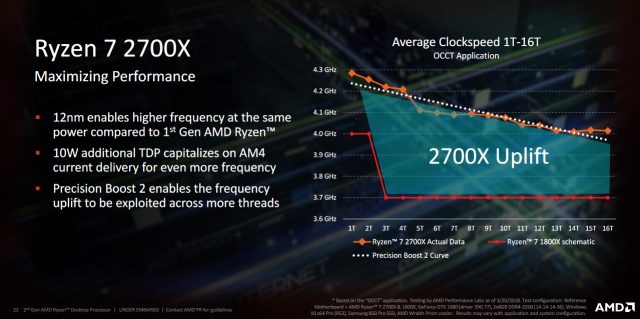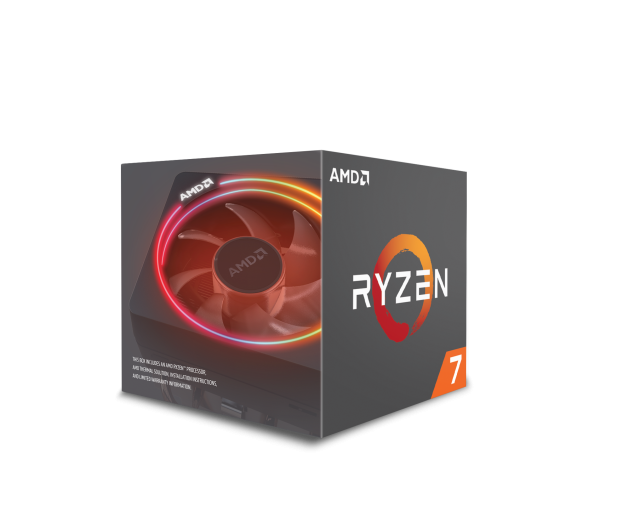
The second-generation Ryzen chips announced last week are now out, and reviews have hit the ‘Net. Unlike the situation last week, we’re now free to talk about what has changed in the second-generation chips and where their improvements lie.

AMD is calling the new parts “Zen+.” This isn’t a new architecture; rather, it’s a tweaked version of the first-generation Zen architecture. The basic layout of the chips remains the same: each contains two core complexes (CCXes), which are blocks of four cores, eight threads, and 8MB level 3 cache, joined with AMD’s Infinity Fabric.
Architecturally, the biggest improvements seem to have been made to memory and cache latencies. AMD says that the cache latency for level 1, level 2, and level 3 caches and main memory have all improved, reduced by up to 13 percent, 34 percent, 16 percent, and 11 percent, respectively. Tech Report’s benchmarks show improved main-memory latency, and PC Perspective found improved communications latency between CCXes.
Overall, AMD says that Zen+ achieves about 3 percent more instructions per cycle (IPC) than the original Zen. This was pretty much spot on with what Anandtech found.
The second-generation parts also have a much smarter version of Precision Boost, AMD’s turbo boosting system. The first-generation chips have a base clock speed, an all-cores boost speed, and a two-thread boost. The highest speeds can only be hit by a single core (two threads); as soon as more than two threads need to have their performance boosted above baseline, the whole chip drops to the all-cores boost speed. Under lighter workloads—those that can use more than two fast cores but fewer than 16—this tends to leave some performance on the table: there’s enough power/thermal headroom to run, say, two or four cores at higher speeds, but the chip simply can’t do it.

Precision Boost 2 addresses this: it can boost any number of cores, just as long as there’s enough power and cooling available. Critically, this means that it can run two or even three core workloads at something higher than the all-cores boost level.
The new chips are also built on Global Foundries’ 12nm process rather than the first-generation 14nm. AMD says that the overall die size and transistor counts are unchanged from the first generation: the company isn’t using the smaller process to pack the chip’s transistors closer together. Rather, it’s getting about another 250MHz and has reduced voltages by about 50mV.
Taken together, the new chips offer an incremental improvement over the old ones: a few hundred more MHz and slightly more work done with each cycle.
First-generation Ryzen chips generally trailed Intel’s processors in single-threaded workloads and most games due to their inferior single-threaded performance. However, they pulled ahead in multithreaded workloads due to their superior core and thread counts. Intel’s six-core, 12-thread Coffee Lake chips closed that gap somewhat, but in tasks with 16 compute-bound threads, the sheer core count of the Ryzens created an unassailable advantage.
The benchmarks of the second-generation parts show a similar pattern. The improved clock speeds and IPC have shrunk the gap in single-threaded tasks and games, but it hasn’t been eliminated: Intel’s i7-8700K is still the best all-around gaming chip, albeit by a smaller margin this time around. But in those tasks where first-generation Ryzen was ahead, second generation is even more ahead.
For example, per PC Perspective, the Intel i7-8700K has frame rates 12-percent higher in Grand Theft Auto V, 29-percent higher in Forza 7, and 7-percent higher in Ghost Recon: Wildlands, and, in single-threaded, Cinebench has an 11-percent performance lead. But by contrast, the Ryzen 2700X is 27-percent quicker in multithreaded Cinebench and 23-percent faster in the POV-Ray ray tracer. These workloads trivially scale to multiple cores, so having more processors and more simultaneous threads is a big advantage for AMD.
And again, as we saw with first-generation parts, it’s not that the AMD chips are bad at gaming. They’re just not quite as quick as the fastest gaming chip available. If you’re building a pure gaming machine, then the Intel chip is probably the one to go for. But if you have broader interests—software development, 3D graphics, even video encoding—then you’re not going to go wrong with the AMD chip.
The second-generation Ryzens work with the same chipsets as the first generation, but AMD also has a new chipset, the X470. The X470 has a couple of notable features: first, it has some integrated USB 3.1 generation 2 (10 gigabit per second) controllers; second, it has StoreMI, a hybrid disk system that enables the use of SSDs (and RAM) to accelerate spinning disks. StoreMI works essentially like RAID 0: the capacity of the system is simply the sum of the SSD and HDD’s capacity, and StoreMI handles moving blocks of data between fast storage and cold storage as appropriate.
This kind of hybrid disk system has its virtues: gamers in particular may have huge Steam libraries, which are prohibitively expensive to store on SSD. A system that puts the games you’re playing actively on the fast SSD, leaving those that you play less often on the slow HDD, is very useful.
However, this kind of system always leaves us a little wary. In practice, most computer users are very bad at making backups, and a RAID 0-type system—where failure of either the SSD or the HDD will leave all your data corrupted and inaccessible—increases the risk of data loss. Systems tied to the motherboard are also a little troublesome: should your motherboard or processor die, you won’t be able to stick the disks in another machine to recover your data unless that other machine also has an X470 chipset. We would, in general, much prefer to see operating system-level hybrid disks instead of these motherboard-provided systems (and this applies both to StoreMI for AMD and Intel’s comparable RST).
We also don’t know how well StoreMI performs yet; the final shipping software and drivers aren’t available yet.
It’s not about the chips; it’s about the trajectory

Overall, the second-generation Ryzens have almost something of an Intel feel to them. Intel for many years had what it called the tick-tock development model: it would alternate between introducing new architectures (“tocks”) and refined versions of those architectures on smaller manufacturing processors (“ticks”). Zen+ isn’t quite an Intel “tick”—Intel’s ticks actually make the processor die smaller, which AMD hasn’t done for Zen+—but it’s nonetheless a small architectural improvement to focus on particular weak spots of the Zen design, paired with a new process.
And critically for AMD, Intel has had to abandon tick-tock due to difficulties with its manufacturing process. Intel’s development of 14nm and 10nm manufacturing have both been delayed, forcing the company to produce multiple generations of processors on 14nm and delaying the transition to 10nm.
The second-generation Ryzens are an incremental improvement on the first generation, but the picture they paint is of a company on the right trajectory. Sure, Intel’s chips are, especially for gamers, the absolute performance champions. But Intel feels like a company that’s struggling to improve on what it has. AMD’s chips might be ever-so-slightly slower, but the company is proving that it can deliver: it gave us a solid first-generation Ryzen, and, about a year later, it has released a superior second generation. It’s heading on the right path while Intel feels lost.
